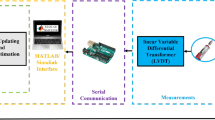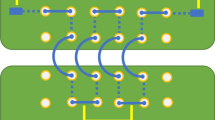Abstract
A This paper presents a position tracking control system for a shape memory alloy (SMA) actuator using neural network (NN) feedforward and robust integral of signum of error (RISE) feedback. Nonlinear control of SMA actuators is difficult due to model uncertainties and unknown disturbances. Discontinuous control techniques such as sliding mode control have conventionally been used to achieve asymptotic tracking in the presence of model uncertainties. However, such discontinuous controllers usually result in increased power loss due to high frequency switching. With the recent development of the continuous RISE feedback control, semi-global asymptotic tracking can be achieved. Furthermore, the NN-RISE control leads to better tracking performance and lower power losses caused by input signal switching/chattering when compared to discontinuous controllers. In order to apply the NN-RISE, a state-space model of the SMA actuator is derived, which has been overlooked in many previous works, using Taylor series expansion and exploiting the nature of SMA dynamics. Experimental results show that the proposed control system works well even in the absence of an accurate model of the SMA actuator.
Similar content being viewed by others
Abbreviations
- h, h 0, h 1 :
-
heat transfer co-efficient parameters
- T amb :
-
ambient temperature, in degrees Celsius
- T :
-
SMA wire temperature
- I :
-
input current
- R m :
-
martensite fraction
- ε:
-
strain
- εo :
-
initial strain in SMA wire
- σ:
-
stress
- Δ:
-
disturbance term
- Δ T :
-
lumped uncertainty term in heat-transfer equation
- x d, x d (i) :
-
desired trajectory, ith time derivative (resp.)
- a 11, a 12, a 21, a 22, b 1, d 1, d 2 :
-
Taylor series expansion parameters
References
Tai, N. T. and Ahn, K. K., “Output Feedback Direct Adaptive Controller for a Sma Actuator with a Kalman Filter,” IEEE Transactions on Control Systems Technology, Vol. 20, No. 4, pp. 1081–1091, 2012.
Ortin, J. and Planes, A., “Thermodynamics of Thermoelastic Martensitic Transformations,” Acta Metallurgica, Vol. 37, No. 5, pp. 1433–1441, 1989.
Boyd, J. G. and Lagoudas, D. C., “A Thermodynamical Constitutive Model for Shape Memory Materials. Part I. The Monolithic Shape Memory Alloy,” International Journal of Plasticity, Vol. 12, No. 6, pp. 805–842, 1996.
Boyd, J. G. and Lagoudas, D. C., “A Thermodynamical Constitutive Model for Shape Memory Materials. Part II. The SMA Composite Material,” International Journal of Plasticity, Vol. 12, No. 7, pp. 843–873, 1996.
Achenbach, M. and Muller, I., “Shape Memory as a Thermally Activated Process,” Elsevier Science Publishing Co., Inc., Plasticity Today: Modelling, Methods and Applications, pp. 515–531, 1985.
Leclercq, S. and Lexcellent, C., “A General Macroscopic Description of the Thermomechanical Behavior of Shape Memory Alloys,” Journal of the Mechanics and Physics of Solids, Vol. 44, No. 6, pp. 953–980, 1996.
Abeyaratne, R. and Knowles, J. K., “Kinetic Relations and the Propagation of Phase Boundaries in Solids,” Archive for Rational Mechanics and Analysis, Vol. 114, No. 2, pp. 119–154, 1991.
Bhattacharyya, A., Lagoudas, D. C., Wang, Y., and Kinra, V. K., “On the Role of Thermoelectric Heat Transfer in the Design of SMA Actuators: Theoretical Modeling and Experiment,” Smart Materials and Structures, Vol. 4, No. 4, pp. 252–263, 1995.
Sun, Q. P. and Hwang, K. C., “Micromechanics Modelling for the Constitutive Behavior of Polycrystalline Shape Memory Alloys−I. Derivation of General Relations,” Journal of the Mechanics and Physics of Solids, Vol. 41, No. 1, pp. 1–17, 1993.
E. Patoor, A., Eberhardt, A., and Berveiller, M, “Micromechanical Modelling of the Shape Memory Behavior,” Proc. of AMe WAM: Mechanics of Phase Transformation and Shape Memory Alloys,” Vol. 189, pp. 23–37, 1994.
Ortin, J., “Preisach Modeling of Hysteresis for a Pseudoelastic Cu- Zn-Al Single Crystal,” Journal of Applied Physics, Vol. 71, No. 3, pp. 1454–1461, 1992.
Feng, Y., Rabbath, C. A., Hong, H., Su, C.-Y., and Lin, W., “Inverse Hysteresis Control for Shape Memory Alloy Micro-Actuators based Flap Positioning System,” Proc. of 49th IEEE Conference on Decision and Control (CDC), pp. 3662–3667, 2010.
Tanaka, K., “A Thermomechanical Sketch of Shape Memory Effect: One-Dimensional Tensile Behavior,” Res Mechanica, Vol. 18, pp. 251–263, 1986.
Liang, C. and Rogers, C. A., “One-Dimensional Thermomechanical Constitutive Relations for Shape Memory Materials,” Journal of Intelligent Material Systems and Structures, Vol. 1, No. 2, pp. 207–234, 1990.
Brinson, L. C., “One-Dimensional Constitutive Behavior of Shape Memory Alloys: Thermomechanical Derivation with Non-Constant Material Functions and Redefined Martensite Internal Variable,” Journal of Intelligent Material Systems and Structures, Vol. 4, No. 2, pp. 229–242, 1993.
Huang, W., “Shape Memory Alloys and their Application to Actuators for Deployable Structures,” Ph.D. Thesis, Department of Engineering, University of Cambridge, 1998.
Elahinia, M. H., Seigler, T. M., Leo, D. J., and Ahmadian, M., “Nonlinear Stress-based Control of a Rotary SMA-Actuated Manipulator,” Journal of Intelligent Material Systems and Structures, Vol. 15, No. 6, pp. 495–508, 2004.
Moallem, M. and Tabrizi, V., “Tracking Control of an Antagonistic Shape Memory Alloy Actuator Pair,” IEEE Transactions on Control Systems Technology, Vol. 17, No. 1, pp. 184–190, 2009.
Elahinia, M. H. and Ahmadian, M., “An Enhanced SMA Phenomenological Model: I. The Shortcomings of the Existing Models,” Smart Materials And Structures, Vol. 14, No. 6, pp. 1297–1308, 2005.
Kirkpatrick, K. and Valasek, J., “Reinforcement Learning for Characterizing Hysteresis Behavior of Shape Memory Alloys,” Journal of Aerospace Computing, Information, and Communication, Vol. 6, No. 3, pp. 227–238, 2009.
Ikuta, K., Tsukamoto, M., and Hirose, S., “Mathematical Model and Experimental Verification of Shape Memory Alloy for Designing Micro Actuator,” Proc. of IEEE Conference on Micro Electro Mechanical Systems, pp. 103–108, 1991.
Madill, D. R. and Wang, D., “Modeling and l 2-Stability of a Shape Memory Alloy Position Control System,” IEEE Transactions on Control Systems Technology, Vol. 6, No. 4, pp. 473–481, 1998.
Dutta, S. M. and Ghorbel, F. H., “Differential Hysteresis Modeling of a Shape Memory Alloy Wire Actuator,” IEEE/ASME Transactions on Mechatronics, Vol. 10, No. 2, pp. 189–197, 2005.
Tai, N. T. and Ahn, K. K., “Adaptive Proportional-Integral-Derivative Tuning Sliding Mode Control for a Shape Memory Alloy Actuator,” Smart Materials and Structures, Vol. 20, No. 5, Paper No. 055010, 2011.
Sreekumar, M., Singaperumal, M., Nagarajan, T., Zoppi, M., and Molfino, R., “Recent Advances in Nonlinear Control Technologies for Shape Memory Alloy Actuators,” Journal of Zhejiang University Science A, Vol. 8, No. 5, pp. 818–829, 2007.
Lee, H. J. and Lee, J. J., “Time Delay Control of a Shape Memory Alloy Actuator,” Smart Materials and Structures, Vol. 13, No. 1, pp. 227–239, 2004.
Choi, S.-B., “Position Control of a Single-Link Mechanism Activated by Shape Memory Alloy Springs: Experimental Results,” Smart Materials and Structures, Vol. 15, No. 1, pp. 51–58, 2006.
Ashrafiuon, H. and Jala, V. R., “Sliding Mode Control of Mechanical Systems Actuated by Shape Memory Alloy,” Journal of Dynamic Systems, Measurement, and Control, Vol. 131, No. 1, Paper No. 011010, 2009.
Song, G. and Ma, N., “Robust Control of a Shape Memory Alloy Wire Actuated Flap,” Smart Materials and Structures, Vol. 16, No. 6, pp. N51–N57, 2007.
Tai, N. T. and Ahn, K. K., “A rbf neural Network Sliding Mode Controller for Sma Actuator,” International Journal of Control, Automation and Systems, Vol. 8, No. 6, pp. 1296–1305, 2010.
Mai, H., Song, G., and Liao, X., “Adaptive Online Inverse Control of a Shape Memory Alloy Wire Actuator using a Dynamic Neural Network,” Smart Materials and Structures, Vol. 22, No. 1, Paper No. 015001, 2013.
Ma, N., Song, G., and Lee, H. J., “Position Control of Shape Memory Alloy Actuators with Internal Electrical Resistance Feedback using Neural Networks,” Smart Materials and Structures, Vol. 13, No. 4, pp. 777–783, 2004.
Eren, Y., Mavroidis, C., and Nikitczuk, J., “B-Spline based Adaptive Control of Shape Memory Alloy Actuated Robotic Systems,” Proc. of ASME International Mechanical Engineering Congress and Exposition, pp. 471–478, 2002.
Xian, B., Dawson, D. M., De Queiroz, M. S., and Chen, J., “A Continuous Asymptotic Tracking Control Strategy For Uncertain Nonlinear Systems,” IEEE Transactions on Automatic Control, Vol. 49, No. 7, pp. 1206–1211, 2004.
Patre, P. M., MacKunis, W., Kaiser, K., and Dixon, W. E., “Asymptotic Tracking for Uncertain Dynamic Systems via a Multilayer Neural Network Feedforward and Rise Feedback Control Structure,” IEEE Transactions on Automatic Control, Vol. 53, No. 9, pp. 2180–2185, 2008.
Shin, J., Kim, H. J., Kim, Y., and Dixon, W. E., “Autonomous Flight of the Rotorcraft-based Uav using Rise Feedback and Nn Feedforward Terms,” IEEE Transactions on Control Systems Technology, Vol. 20, No. 5, pp. 1392–1399, 2012.
MacKunis, W., Patre, P. M., Kaiser, M. K., and Dixon, W. E., “Asymptotic Tracking for Aircraft via Robust and Adaptive Dynamic Inversion Methods,” IEEE Transactions on Control Systems Technology, Vol. 18, No. 6, pp. 1448–1456, 2010.
Selmic, R. R. and Lewis, F. L., “Deadzone Compensation in Motion Control Systems using Neural Networks,” IEEE Transactions on Automatic Control, Vol. 45, No. 4, pp. 602–613, 2000.
Bellouard, Y., “Shape Memory Alloys for Microsystems: A Review from a Material Research Perspective,” Materials Science and Engineering: A, Vol. 481, pp. 582–589, 2008.
Author information
Authors and Affiliations
Corresponding author
Rights and permissions
About this article
Cite this article
Awan, A.U., Park, J., Kim, H.J. et al. Adaptive control of a shape memory alloy actuator using neural-network feedforward and RISE feedback. Int. J. Precis. Eng. Manuf. 17, 409–418 (2016). https://doi.org/10.1007/s12541-016-0051-7
Received:
Revised:
Accepted:
Published:
Issue Date:
DOI: https://doi.org/10.1007/s12541-016-0051-7




